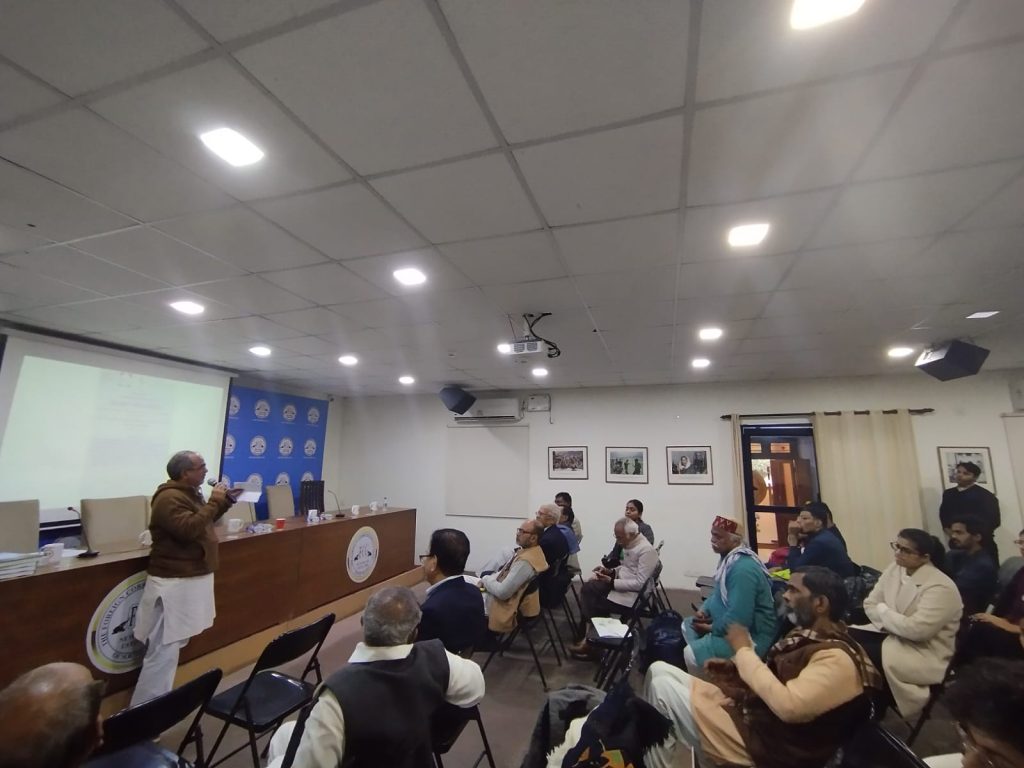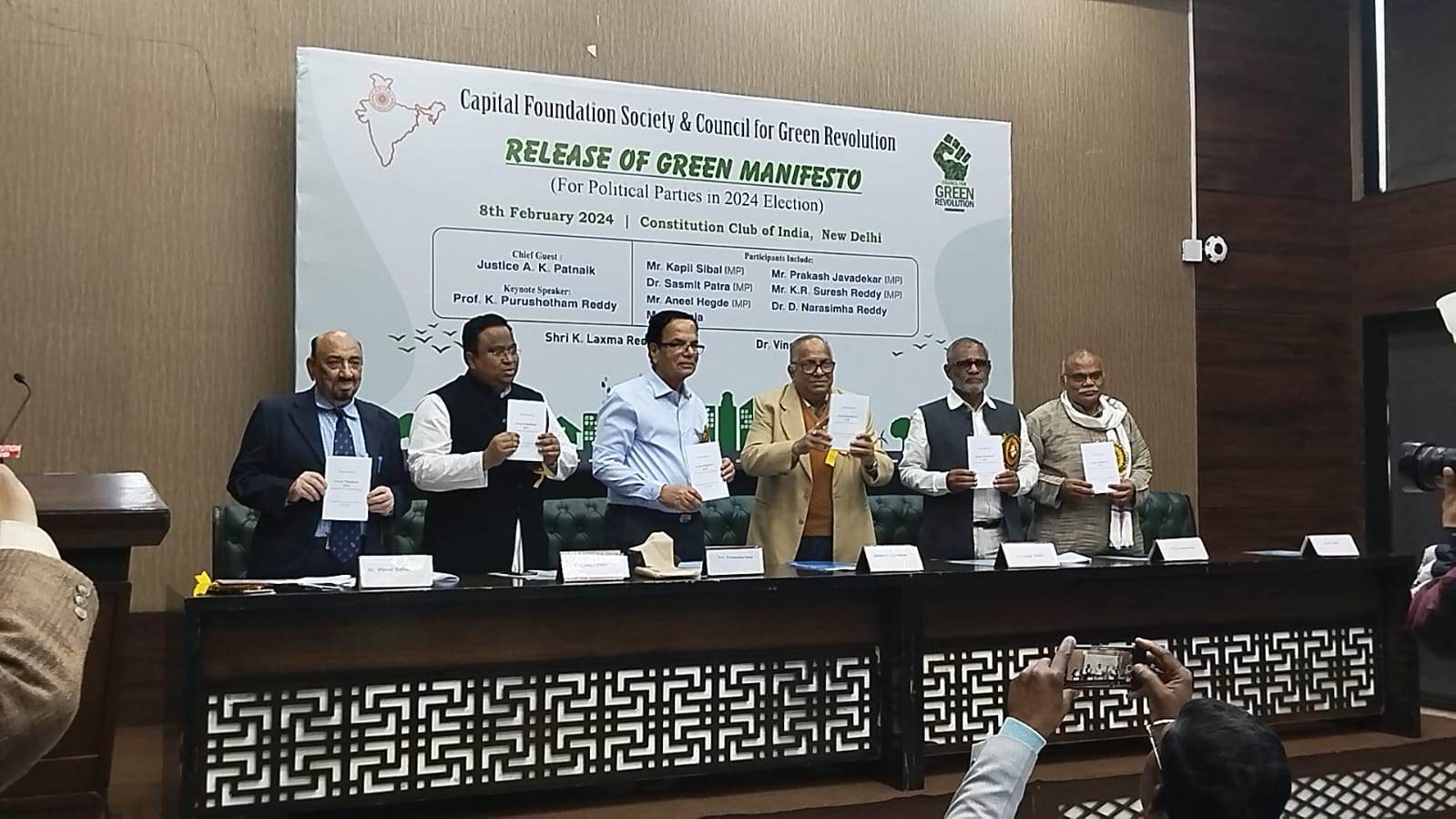During COP26, the 26th United Nations Climate Change conference held in Glasgow with the participation of over 200 countries, our Honourable Prime Minister pledged that India would achieve the target of net-zero emissions by 2070. Alongside reducing our carbon emissions, other commitments were made, including reaching 500GW non-fossil energy capacity by 2030, obtaining 50% of its energy requirements from renewable sources by 2030, reducing total projected carbon emissions by one billion tonnes from now to 2030, and lowering the carbon intensity of the economy by 45% by 2030 over 2005 levels. While the commitments at the International Summit reflect the positive steps taken by countries across the globe, the alarming rate of climate change necessitates tangible interventions. The Green Manifesto, with its ’20-point program,’ aims to provide direction to political parties in India for a sustainable development agenda in the 2024 elections.
Why a Green Manifesto

In the latest IPCC report of 2023, it is highlighted that there is more than a 50% chance that the global temperature rise will reach or surpass 1.5 degrees Celsius (2.7 degrees Fahrenheit) between 2021 and 2040. The effects of climate change are expected to be more severe in the global south, as the report mentions that in the next decade, climate change will drive 32-132 million more people into extreme poverty and have a severe impact on biodiversity and ecology. Therefore, adaptation measures to the alarming crisis are needed right away.
During the release of the manifesto, Justice A.K. Patnaik stressed the need for a green manifesto by reiterating that Article 21 of the Indian Constitution guarantees everyone a right to life, which is dignified. A right to a dignified life is not possible if the environment is degraded on a day-to-day basis. Therefore, the Right to a Pollution-Free Environment is a fundamental right of every human being.
In India, political discourses determine the policies and initiatives of the government. The manifestos of political parties, released before every election, are the only documents that authentically explain the position of each political party (PP). However, these documents lack depth and vision, especially on issues of sustainability and climate change.
The consultation workshop stressed that our focus in the last several years has been to enrich these PP manifestos. The primary objective of this workshop is to generate debate and facilitate the development of policies towards climate action and ecological conservation. Dr. Purshottam Reddy emphasized that “Development has to be sustainable, and there is no other choice.” He further added that the Green Manifesto is an essential document because there is now an urgent need for reforms and measures for active intervention.
On this path, SDGs can be a powerful instrument for leveraging transformative change that addresses inequity and injustice first. Despite India being a signatory to the international program of achieving Sustainable Development Goals (SDGs), not much thought and action have gone into this, both by the government and the people alike. In India, political will is seen as a powerful tool for change. However, political parties are yet to take cognizance of SDGs and the need to integrate environmental concerns into them.
People-centric Manifesto – Features of Green Manifesto

Dr. Narsimha Reddy stated that “SDGs provide a comprehensive framework for transformation, including constituencies of the poor, disempowered, and downtrodden, even while addressing ecological concerns.” Since India is one of the signatories to the Sustainable Development Goal (SDG), loading SDGs onto political party manifestos can be one method of pushing India deeper into the commitments made at the Paris Conference on Climate Change (COP21) in 2015.
At the Rio Conference in 1992, it was emphasized that economic, social, political, and environmental aspects are interlinked. The Green Manifesto puts Nature at the center of employment, the economy, development, and growth, at the same time asserting that the current model of development is not sustainable. Therefore, a paradigm change is needed. Even economic measures such as GDP contribute to environmental destruction because it doesn’t account for biodiversity loss. A better alternative of measurement is the Better Life Index and the National Happiness Index.
The environmental measures laid out by different court judgments, especially the 1986 Supreme Court Judgment which gave direction to establish the “Environmental Protection Act,” have still not been implemented. Dr. Purshottam Reddy stated that “there are still no autonomous authorities to implement various environmental acts which result in widespread climate disaster.” Further, he emphasized that the word ‘sustainable’ should be included in the preamble of the country, and the Directive Principle should include Sustainable Development Goals.

Dr. Donthi Narasimha Reddy, the principal author, says, “Green Manifesto addresses three key dimensions of ecological sustainability, diversity, and equity. It emphasizes on diversity and plurality of knowledge and expertise.” Green Manifesto argues for an integrated resource planning approach, which interlinks economic growth (livelihoods, green skills, etc.), equity (access, subsidies, quality of service), and nature sustainability (internalizing impacts, promoting climate-friendly energy sources, food systems).
Green Manifesto calls for employment creation by shifting economic priorities to responsible production and sustainable consumption. Green skills have to be given priority, even though universal education should receive a level of policy attention. This SDG-related document calls for the application of 3 principles – the precautionary principle, the polluter pays principle, and the biosafety principle. Public policies in India should focus on 3Rs – reduce, reuse, and recycle – wherever reduction in material consumption and material change is not possible.
Political parties are being called upon to increase access to zero chemical-residue food systems (natural, organic). Further, gender equality is both a human rights principle and a precondition for sustainable, people-centered development. In general, some path-breaking suggestions are:
- Food, water, land, and health linkages have to be acknowledged, through appropriate, transformative public policies.
- India’s agriculture should be de-chemicalized and decarbonized.
- An Annual Water budget would be developed and presented in the national Parliament and respective State Legislatures.
- The Indian economy should be decarbonized. As part of this, the National Fibre Policy should encourage natural fibers.
- An Equal Opportunities Commission should be created to address all kinds of discrimination.
- Cities should be production, consumption, and recycling centers of air, water, food, and energy.
- Phase out plastic production and petrol & diesel vehicles by 2030.
- The Environment Impact Assessment of the annual National Budget has to be done.
- Restore major ecological systems in the Eastern Ghats, Himalayas, Western Ghats, and northeast India.
- A National Environment Protection Authority needs to be established.
A Green Manifesto calls for achieving sustainable development, reducing future economic, environmental, and social costs, strengthening economic competitiveness, and reducing poverty.
20-point program
A concise set of programmatic actions, wherein each one includes deeper steps for realization.
- Power to People – local self-government should be strengthened.
- Rejuvenation of the rural economy.
- Ecosystem conservation, land restoration, and livelihood support.
- Common property resources ownership with people and villages.
- Food Security through diversity and local production.
- Public policy development process review – consultative and participatory.
- Poverty Eradication.
- Education for All.
- Health for All.
- Support to Farmers in soil conservation, agroecology, and remunerative prices.
- Decarbonization of the Indian economy – phasing out coal and fossil fuels.
- Welfare – women, child, youth, and old and labor.
- Clean Drinking Water.
- Housing for the poor.
- Land use policy, including distribution and redistribution.
- Cooperatives to be strengthened.
- Civil society organizations should be liberalized from state control.
- Trade review – local production to get priority.
- Autonomy to Constitutional Institutions, such as Election Commission, Central Information Commission, Reserve Bank of India.
- Review of political parties’ role in elections – regulation is the goal.
Political Rights and Climate Justice

Rajendra Ravi (Program Coordinator, PRC) reemphasized that the PRC is in full support of the vision and spirit of the Green Manifesto. Further, he also said that Political Parties might include our demands in their manifesto but still, that doesn’t guarantee that our demands will be implemented. Therefore, the challenge is for the political rights of the people. Without the democratic and political rights of the people, a vision for climate justice cannot be fulfilled. Hence, it’s essential to interconnect the questions of Political Rights and Environmental Rights.
Report prepared by Kislay (Research Assistant, PRC)

